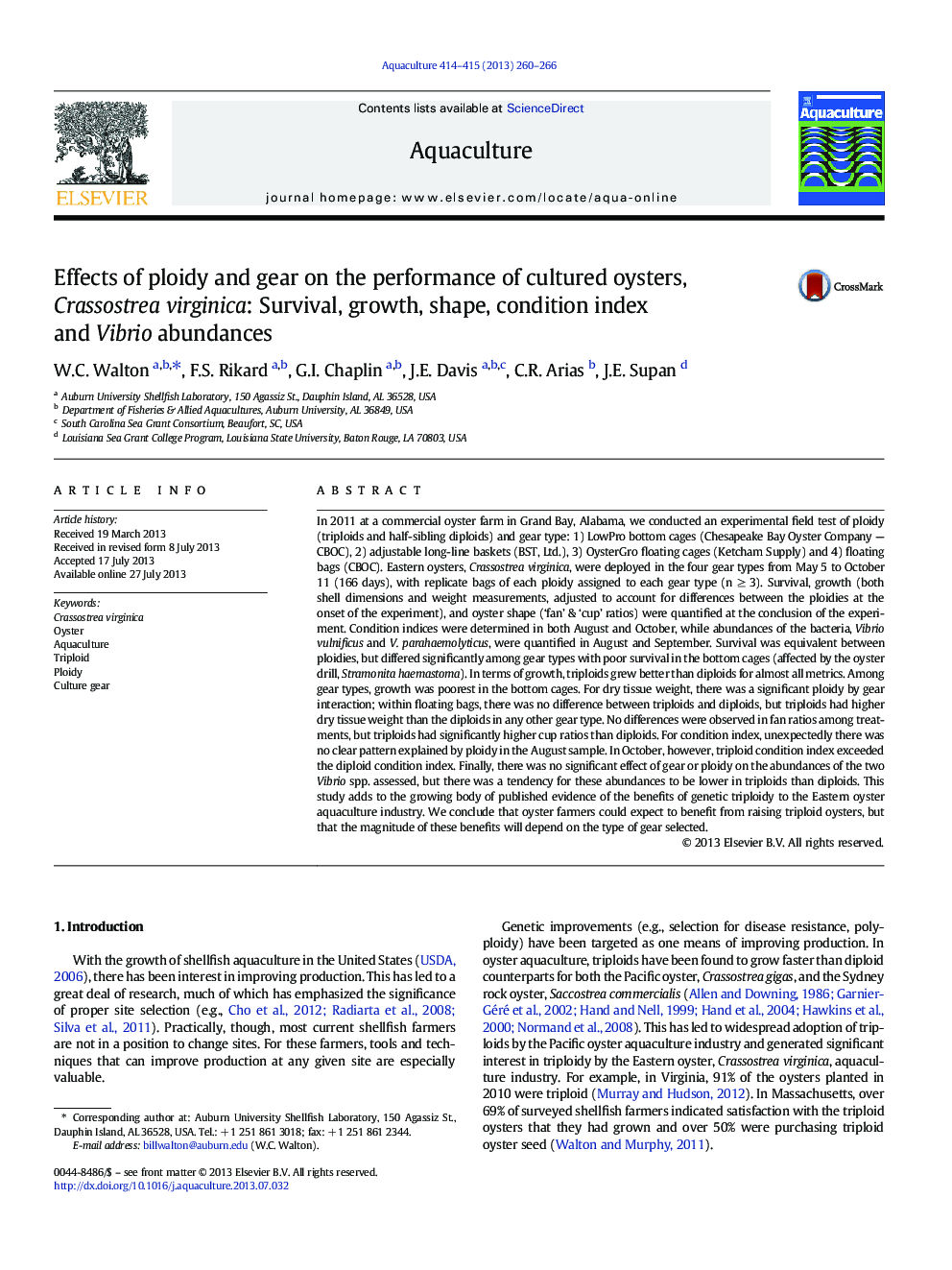| کد مقاله | کد نشریه | سال انتشار | مقاله انگلیسی | نسخه تمام متن |
|---|---|---|---|---|
| 8495432 | 1552866 | 2013 | 7 صفحه PDF | دانلود رایگان |
عنوان انگلیسی مقاله ISI
Effects of ploidy and gear on the performance of cultured oysters, Crassostrea virginica: Survival, growth, shape, condition index and Vibrio abundances
دانلود مقاله + سفارش ترجمه
دانلود مقاله ISI انگلیسی
رایگان برای ایرانیان
کلمات کلیدی
موضوعات مرتبط
علوم زیستی و بیوفناوری
علوم کشاورزی و بیولوژیک
علوم آبزیان
پیش نمایش صفحه اول مقاله

چکیده انگلیسی
In 2011 at a commercial oyster farm in Grand Bay, Alabama, we conducted an experimental field test of ploidy (triploids and half-sibling diploids) and gear type: 1) LowPro bottom cages (Chesapeake Bay Oyster Company - CBOC), 2) adjustable long-line baskets (BST, Ltd.), 3) OysterGro floating cages (Ketcham Supply) and 4) floating bags (CBOC). Eastern oysters, Crassostrea virginica, were deployed in the four gear types from May 5 to October 11 (166 days), with replicate bags of each ploidy assigned to each gear type (n â¥Â 3). Survival, growth (both shell dimensions and weight measurements, adjusted to account for differences between the ploidies at the onset of the experiment), and oyster shape ('fan' & 'cup' ratios) were quantified at the conclusion of the experiment. Condition indices were determined in both August and October, while abundances of the bacteria, Vibrio vulnificus and V. parahaemolyticus, were quantified in August and September. Survival was equivalent between ploidies, but differed significantly among gear types with poor survival in the bottom cages (affected by the oyster drill, Stramonita haemastoma). In terms of growth, triploids grew better than diploids for almost all metrics. Among gear types, growth was poorest in the bottom cages. For dry tissue weight, there was a significant ploidy by gear interaction; within floating bags, there was no difference between triploids and diploids, but triploids had higher dry tissue weight than the diploids in any other gear type. No differences were observed in fan ratios among treatments, but triploids had significantly higher cup ratios than diploids. For condition index, unexpectedly there was no clear pattern explained by ploidy in the August sample. In October, however, triploid condition index exceeded the diploid condition index. Finally, there was no significant effect of gear or ploidy on the abundances of the two Vibrio spp. assessed, but there was a tendency for these abundances to be lower in triploids than diploids. This study adds to the growing body of published evidence of the benefits of genetic triploidy to the Eastern oyster aquaculture industry. We conclude that oyster farmers could expect to benefit from raising triploid oysters, but that the magnitude of these benefits will depend on the type of gear selected.
ناشر
Database: Elsevier - ScienceDirect (ساینس دایرکت)
Journal: Aquaculture - Volumes 414â415, 15 November 2013, Pages 260-266
Journal: Aquaculture - Volumes 414â415, 15 November 2013, Pages 260-266
نویسندگان
W.C. Walton, F.S. Rikard, G.I. Chaplin, J.E. Davis, C.R. Arias, J.E. Supan,